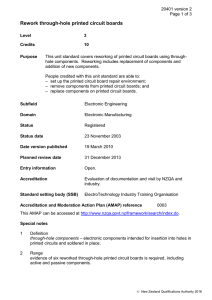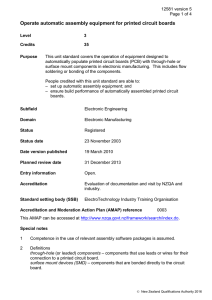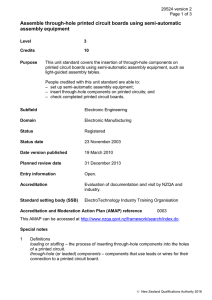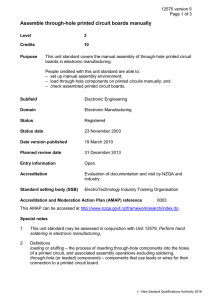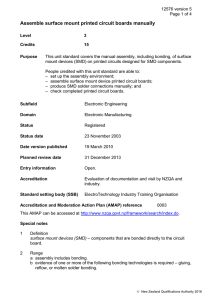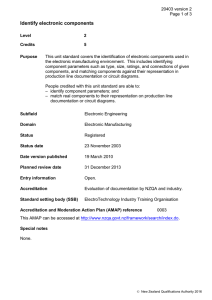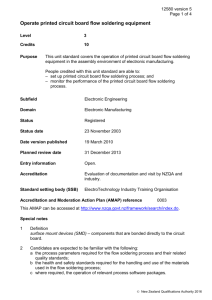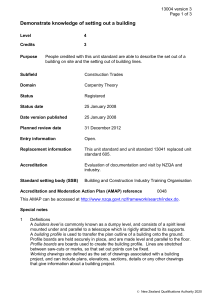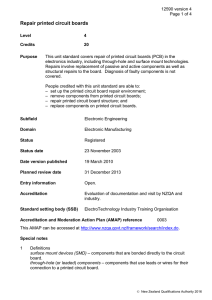Rework surface mount printed circuit boards
advertisement
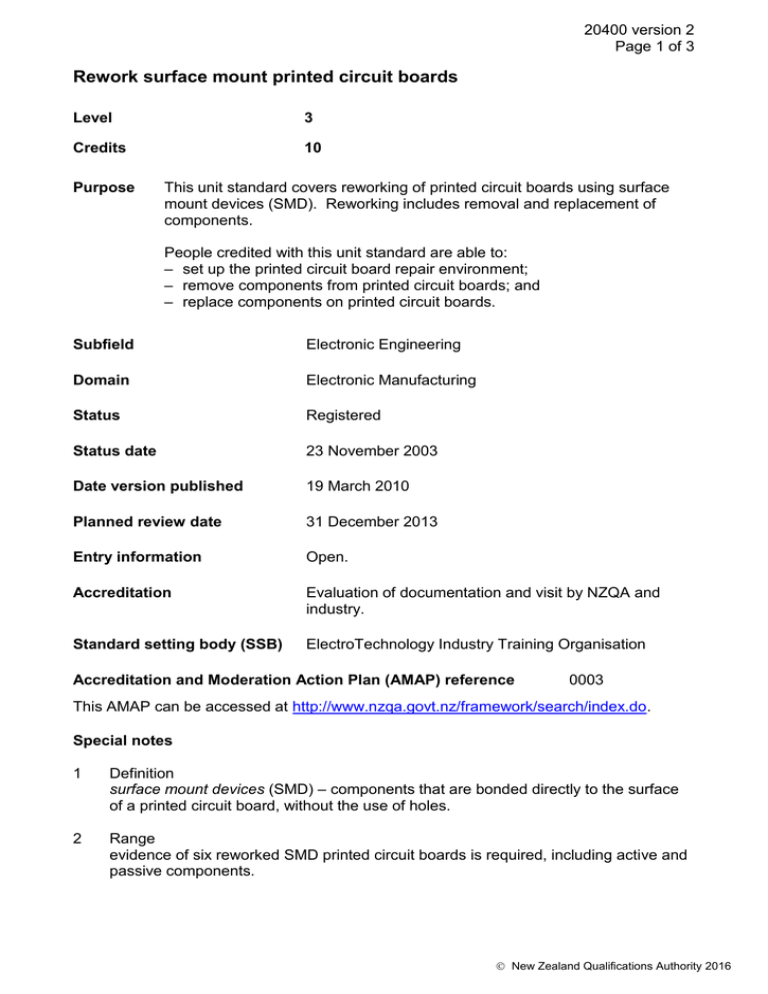
20400 version 2 Page 1 of 3 Rework surface mount printed circuit boards Level 3 Credits 10 Purpose This unit standard covers reworking of printed circuit boards using surface mount devices (SMD). Reworking includes removal and replacement of components. People credited with this unit standard are able to: – set up the printed circuit board repair environment; – remove components from printed circuit boards; and – replace components on printed circuit boards. Subfield Electronic Engineering Domain Electronic Manufacturing Status Registered Status date 23 November 2003 Date version published 19 March 2010 Planned review date 31 December 2013 Entry information Open. Accreditation Evaluation of documentation and visit by NZQA and industry. Standard setting body (SSB) ElectroTechnology Industry Training Organisation Accreditation and Moderation Action Plan (AMAP) reference 0003 This AMAP can be accessed at http://www.nzqa.govt.nz/framework/search/index.do. Special notes 1 Definition surface mount devices (SMD) – components that are bonded directly to the surface of a printed circuit board, without the use of holes. 2 Range evidence of six reworked SMD printed circuit boards is required, including active and passive components. New Zealand Qualifications Authority 2016 20400 version 2 Page 2 of 3 3 References Health and Safety in Employment Act 1992; Hazardous Substances and New Organisms Act 1996; IPC-A-610D, Acceptability of Electronic Assemblies, 2005, published by IPC – Association Connecting Electronics Industries; IPC-7711B/7721B, Rework, Modification and Repair of Electronic Assemblies, November 2007, published by IPC – Association Connecting Electronics Industries. 4 The following apply to all elements of this unit standard: a all activities are to be completed and reported within agreed timeframes; b all work practices must meet worksite's documented quality management requirements; c all activities must comply with policies, procedures and requirements of the enterprises involved; and any relevant legislative and/or regulatory requirements, which include, but are not limited to, the Health and Safety in Employment Act 1992 and the Hazardous Substances and New Organisms Act 1996. Elements and performance criteria Element 1 Set up the printed circuit board repair environment. Performance criteria 1.1 The workplace layout conforms to enterprise safety standards and presents no uncontrolled hazards to any person. 1.2 The selected equipment, settings, and materials are suitable for the type of rework. Range 1.3 equipment – thermal capacity, tip shape and size; settings – temperature, gas flows, solder removal; materials – flux, cleaning materials, paste. Measures to prevent damage from electrostatic discharge are applied. Element 2 Remove components from printed circuit boards. Performance criteria 2.1 The removal process causes no damage to printed circuit boards or adjacent components. New Zealand Qualifications Authority 2016 20400 version 2 Page 3 of 3 Element 3 Replace components on printed circuit boards. Performance criteria 3.1 Placement, and bonding or soldering of components do not damage printed circuit boards, the components being added, or adjacent components. 3.2 Reworked boards meet IPC and enterprise quality standards. Please note Providers must be accredited by NZQA, or an inter-institutional body with delegated authority for quality assurance, before they can report credits from assessment against unit standards or deliver courses of study leading to that assessment. Industry Training Organisations must be accredited by NZQA before they can register credits from assessment against unit standards. Accredited providers and Industry Training Organisations assessing against unit standards must engage with the moderation system that applies to those standards. Accreditation requirements and an outline of the moderation system that applies to this standard are outlined in the Accreditation and Moderation Action Plan (AMAP). The AMAP also includes useful information about special requirements for organisations wishing to develop education and training programmes, such as minimum qualifications for tutors and assessors, and special resource requirements. Comments on this unit standard Please contact the ElectroTechnology Industry Training Organisation reviewcomments@etito.co.nz if you wish to suggest changes to the content of this unit standard. New Zealand Qualifications Authority 2016
